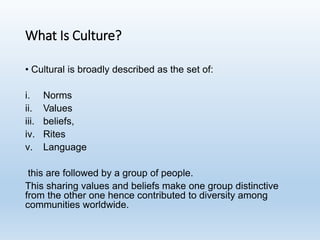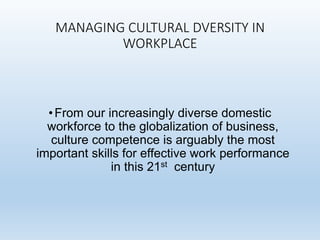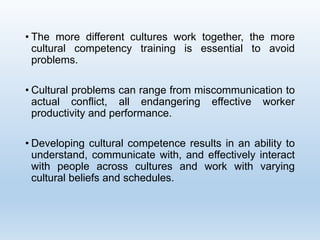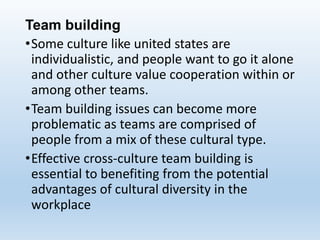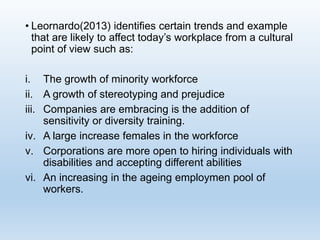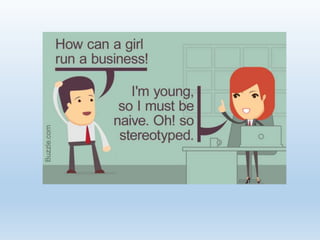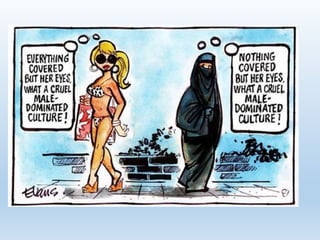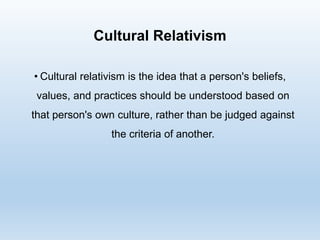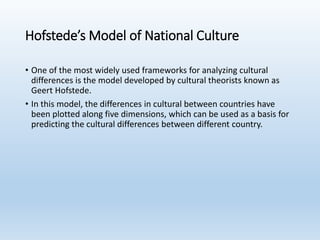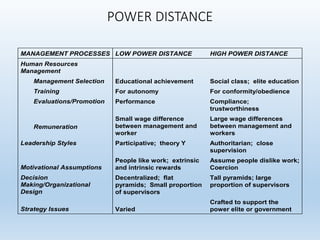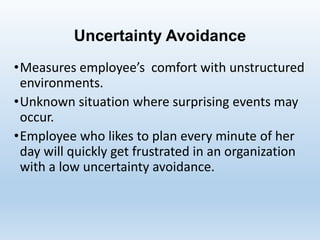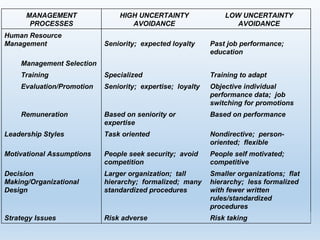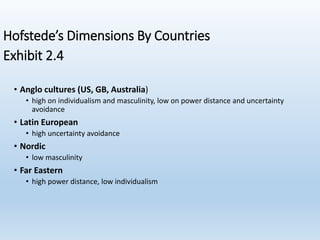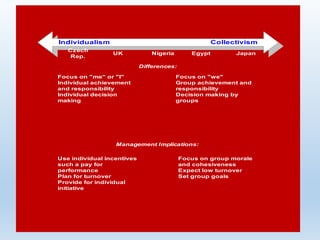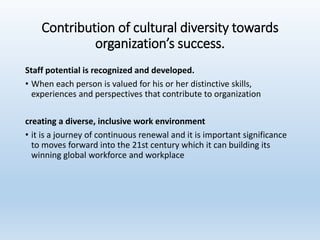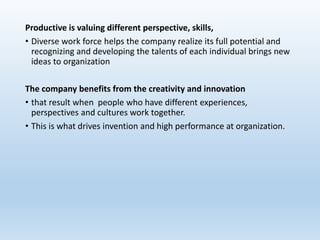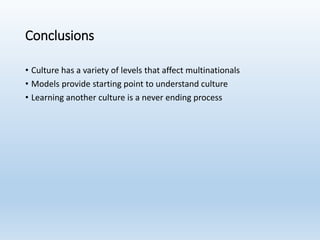Culture and Communication in the Global Workforce.ppt
- 1. Culture and Communication in the Global Workforce
- 2. What Is Culture? • Cultural is broadly described as the set of: i. Norms ii. Values iii. beliefs, iv. Rites v. Language this are followed by a group of people. This sharing values and beliefs make one group distinctive from the other one hence contributed to diversity among communities worldwide.
- 3. culture • It is interesting to see how cultural blends within the work environment. • All managers are eager to see their business prosper. • From ethnocentric perspective of the organization to a polycentric one which is more visible today than even before. • Manager have to deal with people from different cultures. • This challenges just increases when companies start their operations abroad and engage themselves in multinational operations. • Business must find out some or many benefits from cultural integration. • Since companies trade beyond traditional barriers, they will have to consider the importance of cultural.
- 4. Culture • Culture is not merely understanding one from a certain point of view • overcoming differences among different people working together will certainly eliminate such gaps and favor good work opportunities among workers. • This is not an easy task and the need for sensitivity or diversity training should be an all inclusive element for a firm’s sustainability within its diversity programmed. • Cultural will remain a pending issues in business seen from what is generally taking place in the world with numerous strife being caused by religious and cultural differences.
- 5. culture • It is up to managers to see how sensitive issues relating to culture can be best approached and how they can avoid prejudice to people from different cultures. • Getting all cultures different on board does matter and this is where there is a need to find out harmony among the workers. • It is right time to scorn off negative values on culture and rather think how one can talk business globally by valuing differences and making the best of individualities in the cultural melting pot
- 6. MANAGING CULTURAL DVERSITY IN WORKPLACE •From our increasingly diverse domestic workforce to the globalization of business, culture competence is arguably the most important skills for effective work performance in this 21st century
- 7. What is culture diversity in the workplace? • Culture refers to the values, norms and traditions that affect the way a member of a group typically perceive, thinks, interacts, behaves, and make judgement. • Culture competence is the ability to interact effectively with people from different cultures. • This ability depends on awareness of one’s own cultural worldview, knowledge of other cultural practices and worldviews, tolerant attitudes towards cultural differences, and cross-cultural skills.
- 8. NATIONAL CULTURE BUSINESS CULTURE ORGANIZATION CULTURE OCCUPATIONAL CULTURE MULTINATIONAL MANAGEMENT
- 9. • The more different cultures work together, the more cultural competency training is essential to avoid problems. • Cultural problems can range from miscommunication to actual conflict, all endangering effective worker productivity and performance. • Developing cultural competence results in an ability to understand, communicate with, and effectively interact with people across cultures and work with varying cultural beliefs and schedules.
- 10. challenging in managing a multicultural environment: Communication •Providing information accurately and promptly is critical to effective work and team performance. •This is particular important when a project is troubled and needs immediate corrective action •People in different culture vary in how for example people from Asian cultures are reluctant to give supervisors bad news while those from other may exaggerate it.
- 11. Team building •Some culture like united states are individualistic, and people want to go it alone and other culture value cooperation within or among other teams. •Team building issues can become more problematic as teams are comprised of people from a mix of these cultural type. •Effective cross-culture team building is essential to benefiting from the potential advantages of cultural diversity in the workplace
- 12. Time •Culture differ in how they view time for example they differ in the balance between work and family life, and the workplace mix between work and social behavior •Other differences include the perception of overtime, or even the exact meaning of a deadline •Different perception of time can cause a great misunderstanding, and mishap in the workplace, especially with scheduling and deadlines
- 13. Cultural Diversity Trends • Cultural diversity is a form of appreciating the differences in individuals. • The differences can be based on i. Gender ii. Age iii. Sex iv. Ethnicity v. Sexual orientation vi. Social status Companies have realized the value in acquiring a diverse workforce.
- 14. • Leornardo(2013) identifies certain trends and example that are likely to affect today’s workplace from a cultural point of view such as: i. The growth of minority workforce ii. A growth of stereotyping and prejudice iii. Companies are embracing is the addition of sensitivity or diversity training. iv. A large increase females in the workforce v. Corporations are more open to hiring individuals with disabilities and accepting different abilities vi. An increasing in the ageing employmen pool of workers.
- 15. Stereotyping • in social psychology, a stereotype is an over- generalized belief about a particular category of people. Stereotypes are generalized because one assumes that the stereotype is true for each individual person in the category
- 19. Ethnocentrism • Ethnocentrism is the act of judging another culture based on preconceptions that are found in values and standards of one's own culture
- 22. Cultural Relativism • Cultural relativism is the idea that a person's beliefs, values, and practices should be understood based on that person's own culture, rather than be judged against the criteria of another.
- 24. Two Diagnostic Models to Aid the Multinational Manager •Hofstede’s Model of National Culture •7d Cultural Dimensions Model
- 25. Hofstede’s Model of National Culture • One of the most widely used frameworks for analyzing cultural differences is the model developed by cultural theorists known as Geert Hofstede. • In this model, the differences in cultural between countries have been plotted along five dimensions, which can be used as a basis for predicting the cultural differences between different country.
- 26. The five dimensions of Hofstede model • POWER DISTANCE • INDIVIDUALISM • MASCULINITY • UNCERTAINTY AVOIDANCE • LONG-TERM ORIENTATION
- 27. MANAGEMENT PROCESSES LOW POWER DISTANCE HIGH POWER DISTANCE Human Resources Management Management Selection Educational achievement Social class; elite education Training For autonomy For conformity/obedience Evaluations/Promotion Performance Compliance; trustworthiness Remuneration Small wage difference between management and worker Large wage differences between management and workers Leadership Styles Participative; theory Y Authoritarian; close supervision Motivational Assumptions People like work; extrinsic and intrinsic rewards Assume people dislike work; Coercion Decision Making/Organizational Design Decentralized; flat pyramids; Small proportion of supervisors Tall pyramids; large proportion of supervisors Strategy Issues Varied Crafted to support the power elite or government POWER DISTANCE
- 28. Individualism •The individualism dimension measures not only the degree to which an employee maintains her unique attributes, but also the degree to which she becomes integrated into the collective group •An individualist employee has loose ties to others in the organization.
- 29. MANAGEMENT PROCESSES LOW INDIVIDUALISM HIGH INDIVIDUALISM Human Resources Management Management Selection Group membership; school or university Universalistic based on individual traits Training Focus on company based skills General skills for individual achievement Evaluation/Promotion Slow with group; seniority Based on individual performance Remuneration Based on group membership/organizational paternalism Extrinsic rewards (money, promotion) based on market value Leadership Styles Appeals to duty and commitment Individual rewards and punishments based on performance Motivational Assumptions Moral involvement Calculative; Individual cost/benefit Decision Making/Organizational Design Group; slow; preference for larger organizations Individual responsibility; preference for smaller organizations
- 30. Masculinity •Measures the organizations' personality against masculine and feminine stereotypes. •A company with masculine culture operate assertively and competitively •A company with a feminine culture come across more modest and caring.
- 31. MANAGEMENT PROCESSES LOW MASCULINITY HIGH MASCULINITY Human Resources Management Management Selection Independent of gender, school ties less important; androgyny Jobs gender identified; school performance and ties important Training Job-Oriented Career oriented Evaluation/Promotion Job performance with less gender role assignments Continues gender tracking Remuneration Less salary differences between levels; more time off More salary preferred to less hours Leadership Styles More theory Y; More theory X; Motivational Assumptions Emphasis on quality of life, time off, vacations; work not central Emphasis on performance and growth; excelling to be best; work central to life; job recognition important Decision Making/Organizational Design Intuitive/group; smaller organizations Decisive/individual; larger organization preferred
- 32. Uncertainty Avoidance •Measures employee’s comfort with unstructured environments. •Unknown situation where surprising events may occur. •Employee who likes to plan every minute of her day will quickly get frustrated in an organization with a low uncertainty avoidance.
- 33. MANAGEMENT PROCESSES HIGH UNCERTAINTY AVOIDANCE LOW UNCERTAINTY AVOIDANCE Human Resource Management Seniority; expected loyalty Past job performance; education Management Selection Training Specialized Training to adapt Evaluation/Promotion Seniority; expertise; loyalty Objective individual performance data; job switching for promotions Remuneration Based on seniority or expertise Based on performance Leadership Styles Task oriented Nondirective; person- oriented; flexible Motivational Assumptions People seek security; avoid competition People self motivated; competitive Decision Making/Organizational Design Larger organization; tall hierarchy; formalized; many standardized procedures Smaller organizations; flat hierarchy; less formalized with fewer written rules/standardized procedures Strategy Issues Risk adverse Risk taking
- 34. Long Term Orientation • The long term orientation is measures long-term values, against short term values such as respect for tradition, fulfilment for social obligations and avoiding personal embarrassment. • Employees with a high measures of a long-term orientation respond well to a hierarchy based organizational structure where leaders are highly respected. • Employees with low measures of long term orientation demonstrate personal stability and observe customers such as reciprocating (to share the same feelings as someone else and to behave in a same way as someone else) favors and gifts from others.
- 35. MANAGEMENT PROCESSES SHORT TERM ORIENTATION LONG TERM ORIENTATION Human Resources Management Management Selection Objective skill assessment for immediate use to company Fit of personal and background characteristics Training Limited to immediate company needs Investment in long term employment skills Evaluation/Promotion Fast; based on skill contributions Slow; develop skills and loyalty Remuneration Pay; promotions Security Leadership Styles Use incentives for economic advancement Build social obligations Motivational Assumptions Immediate rewards necessary Subordinate immediate gratification for long term individual and company goals Decision Making/Organizational Design Logical analyses of problems; design for logic of company situation Synthesis to reach consensus; design for social relationships Strategy Issues Fast; measurable payback Long term profits and growth; Incrementalism
- 36. Hofstede’s Dimensions By Countries Exhibit 2.4 • Anglo cultures (US, GB, Australia) • high on individualism and masculinity, low on power distance and uncertainty avoidance • Latin European • high uncertainty avoidance • Nordic • low masculinity • Far Eastern • high power distance, low individualism
- 37. The 7 Dimension of Culture Cultural • The 7 dimensions of culture is the most recognized cultural theory model co-created by Trompenaars and Hampden-Turner (1997) • The theory was created to help understanding and managing cultural differences • Trompenaars’ theory focuses on the way people think, their foresights, behavior and future expectations • He believed culture is a way a group of people solve problems.
- 39. Universalism Particularism Focus on Rules Contracts difficult to break Trustworthy people honor their word Belief in is only one reality "Deals" are obligations Focus on Relationships Contracts easy to modify Trustworthy people adapt to each other's needs based on trust Reality is relative to each person's situation "Deals" are flexible to the situation and the person USA UK Czech Rep. Nigeria Mexico South Korea Differences: Management Implications: Use procedures applied to all Formalize business practices Announce changes publicly Treat all cases similarly Use informal networks to create understanding Make changes subtly and privately Treat each case based on its unique circumstances
- 40. Individualism Collectivism Focus on "me" or "I" Individual achievement and responsibility Individual decision making Focus on "we" Group achievement and responsibility Decision making by groups UK Czech Rep. Nigeria Egypt Japan Differences: Management Implications: Use individual incentives such a pay for performance Plan for turnover Provide for individual initiative Focus on group morale and cohesiveness Expect low turnover Set group goals
- 41. Neutral Affective Do not reveal thought or feelings Control over emotions admired Physical contact and expressive gestures avoided Feelings and thoughts reveal verbally and non- verbally Emotional expression uninhibited Animated expression and gesturing admired Touching is common Sweden UK Czech Rep. Norway Mexico China Differences: Management Implications: Act under control to show status Keep dialogue to the point Avoid appearing detached, which suggests distance Expect strong commitment to positions Tolerate emotional outbursts
- 42. Specific Diffuse Direct in relationships Blunt and precise in communication Principled moral reasoning Indirect and subtle in relationships Ambiguous or evasive in communication Situation-based moral decision making Sweden UK Czech Rep. Norway Mexico China Differences: Managerial Implications: Use of objectives and standards Separate private and business lives Give clear and precise directions Attempt continuous improvement Mix private and business lives Use ambiguous directions to give employees latitude
- 43. Achievement Ascription Use title only when relevant Superiors earn respect through job performance Mixture of age and gender in management Use of titles common and expected Respect for superior shows commitment to organization Background and age main qualification for management Norway Austria Ireland Japan Hong Kong Argentina Differences: Managerial Implications: Emphasize rewards and respect based on skills and accomplishments Senior level managers defer to technical and functional specialists Emphasize seniority Use personal power of superior for rewards Emphasize the chain of command
- 44. Past/Present Future Communication references history and origins of country, business, and family Respect for past glory and elders History provides a context for present actions Communication refers to potential achievements Planning important Potential for future advantage emphasized Hong Kong Israel Russia Korea Hong Kong Differences: Managerial Implications: Emphasize and be sensitive to history and tradition Avoid strict deadlines for completion of tasks Motivate by emphasis on opportunities Set specific deadlines Enjoy the moment Planning seldom results in execution Immediate impact most important Past Present Future Past and Present Future
- 45. How to maintain cultural synergy •Affirmative action - Initiating proactive behaviors and action in making equal employment opportunity to everyone •Workforce diversity - Creating an inclusive work environment that values all employees •Global diversity -Putting differences to work in the market place, workplace and community
- 46. Benefits of having a cultural diversity in workplace •Diversity is beneficial to both associates and employees •Diversity in the workplace can reduce lawsuit •Diversity encourage flexibility and creativity •Diversity increase marketing opportunities •Diversity develop business image
- 47. Contribution of cultural diversity towards organization’s success. Staff potential is recognized and developed. • When each person is valued for his or her distinctive skills, experiences and perspectives that contribute to organization creating a diverse, inclusive work environment • it is a journey of continuous renewal and it is important significance to moves forward into the 21st century which it can building its winning global workforce and workplace
- 48. Productive is valuing different perspective, skills, • Diverse work force helps the company realize its full potential and recognizing and developing the talents of each individual brings new ideas to organization The company benefits from the creativity and innovation • that result when people who have different experiences, perspectives and cultures work together. • This is what drives invention and high performance at organization.
- 49. Conclusions • Culture has a variety of levels that affect multinationals • Models provide starting point to understand culture • Learning another culture is a never ending process

